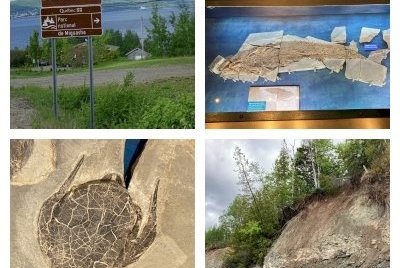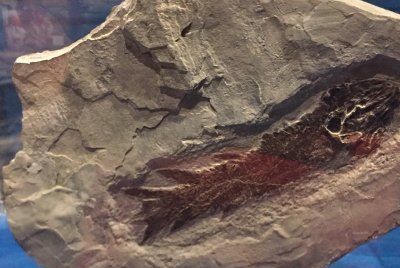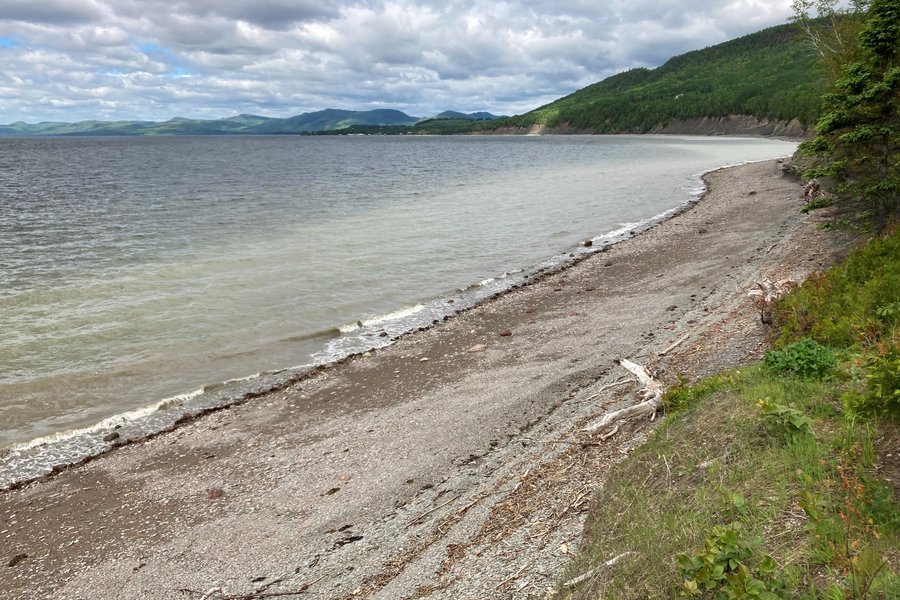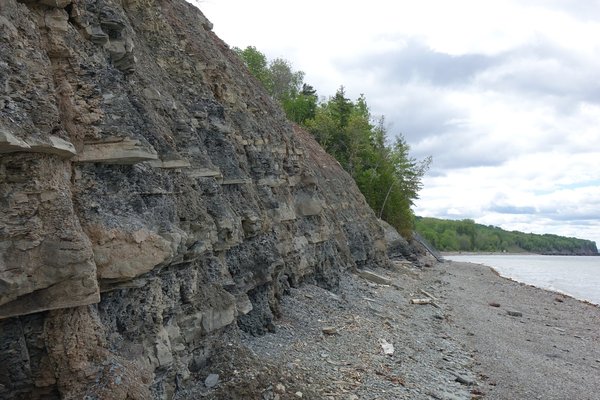Canada
Miguasha National Park
Miguasha National Park protects the world's greatest palaeontological record of fossils from the Devonian Period, known as the 'Age of Fishes'.
The fish, invertebrate and plant fossils were found at a coastal rock formation. Five of the six main fossil fish groups from this period (dating from 370 million years) can be found here. A great quantity of some of the best-preserved fossil specimens of lobe-finned fish, ancestors to the tetrapods (believed to be the first four-legged air-breathing terrestrial vertebrates), were found here.
Community Perspective: the museum with its collection of well-preserved fossils comes recommended, while there isn’t much to see ‘outside’ anymore.
Site Info
Official Information
- Full Name
- Miguasha National Park (ID: 686)
- Country
- Canada
- Status
-
Inscribed 1999
Site history
History of Miguasha National Park
- 1999: Inscribed
- Inscribed
- 1994: Referred
- Bureau - importance recognised but lacked context in which to judge comparatively. Centre to organise a study into sites covering Earth's evolutionary history
- Type
- Natural
- Criteria
- viii
Links
- UNESCO
- whc.unesco.org
- Official
-
- sepaq.com — National Park
- Related
-
- miguasha.ca — Virtual museum
- world-heritage-datasheets.unep-wcmc.org — UNEP-WCMC Datasheet
- cbc.ca — World's oldest fossils discovered in the Restigouche River basin
All Links
UNESCO.org
- whc.unesco.org — whc.unesco.org/
Official Website
- sepaq.com — National Park
Related Resources
- miguasha.ca — Virtual museum
- world-heritage-datasheets.unep-wcmc.org — UNEP-WCMC Datasheet
- cbc.ca — World's oldest fossils discovered in the Restigouche River basin
Community Information
- Community Category
- Paleontology: Non-hominid fossils
Travel Information
Recent Connections
-
Petrified wood
Fossil evidence of Archaeopteris at Mig…
-
Linear inscriptions
Thin strip along the coastline
-
IUGS Geological Heritage Sites
The Late Devonian fossil-fish Lagerstät…
Connections of Miguasha National Park
- Geography
-
-
Linear inscriptions
Thin strip along the coastline
-
- Trivia
-
-
Smallest natural WHS
87 ha (4)
-
- Ecology
-
-
Petrified wood
Fossil evidence of Archaeopteris at Miguasha includes not only impressions of its fern-like fronds but also pieces of carbonized and petrified trunks. (source)
-
Fossils
In its representation of vertebrate life, Miguasha is the most outstanding fossil site in the world for illustrating the Devonian as the 'Age of Fishes'. (OUV, crit viii) -
Fish
Crit viii: "The site is of paramount importance because it has the largest number and the best-preserved fossil specimens in the world of sarcopterygian fish" -
Lagerstätten
(Devonian) "Some of the fish, fauna, and spore fossils found at Miguasha are rare and ancient species" (Wiki)See en.wikipedia.org
-
- World Heritage Process
-
-
Inscribed on a single criterion only
viii. to be outstanding examples representing major stages of earth's history, including the record of life, significant on-going geological processes in the development of landforms, or significant geomorphic or physiographic features
-
- WHS on Other Lists
-
-
IUGS Geological Heritage Sites
The Late Devonian fossil-fish Lagerstätte of Miguasha
-
- Timeline
-
-
Paleozoic
The fossils date back to the Devonian, "a geologic period and system of the Paleozoic, spanning 60.3 million years from the end of the Silurian, 419.2 million years ago (Mya), to the beginning of the Carboniferous, 358.9 Mya" (wiki)
-
- Science and Technology
-
-
Scientific Developments
Of great importance is the presence of the crossopterygian group of fishes, which share many characteristics with the tetrapods: (four-legged land animals). It was the discovery of one of these, the Eusthenopteron (the so-called “Prince of Miguasha”) which focused the attention of the international scientific community on the Escuminac Formation, giving rise to the modern conception of evolution from fish to land dwelling vertebrates. (AB ev)
-
- WHS Names
-
-
Untranslated Toponyms
derived from Megouasag which means "red cliffs" in Micmac -
Name changes
national added (2004)
-
News
No news.
Recent Visitors
Visitors of Miguasha National Park
- Alexander Barabanov
- Ana Lozano
- Antonio J.
- Argo
- Atila Ege
- AYB
- brornt
- Cody Ayers
- CynthiaW
- Els Slots
- Fan Yibo
- Frédéric M
- Gary Arndt
- George Gdanski
- GeorgeIng61
- Gernot
- Iain Jackson
- Janos
- Jarek Pokrzywnicki
- Jawnbeary
- Jay T
- Jeanne OGrady
- Jonas Hagung
- Jonas Kremer
- KeithBailey
- Kevin247
- Lara Adler
- Lembu
- Luis Filipe Gaspar
- Mazeman
- MH
- Michael Ayers
- Mihai Dascalu
- Morodhi
- Mstrebl1990
- Nihal Ege
- Nolan B.
- Philipp Leu
- Philipp Peterer
- Randi Thomsen
- Roger Ourset
- Roman Bruehwiler
- Svein Elias
- Szucs Tamas
- Thomas van der Walt
- Tim Allen
- Van Hung
- Vsacan
- Wojciech Fedoruk
- ZCTLife
- Zoë Sheng
Community Reviews
Show full reviews
The further north I drove from the provincial capital Québec towards Miguasha, the more dramatic the scenery became: fast-flowing rivers for salmon fishing, dense forests, and the first ‘real’ mountains: the Appalachians. Kilometers before the exit from the highway, the Miguasha World Heritage Site is already signposted. Encountering a prominent sign like this always makes me happy, especially on this trip as ones with the UNESCO logo are quite rare among Canadian WHS.
I visited the park at the opening hour of 9 a.m. and at the visitor center they had to unlock the door for me. That center is of an impressive size by the way, compared to the relatively small site it covers. The girl at the reception started her enthusiastic explanations about what you can do here in Quebec-French. Fortunately, I kind of knew what I wanted to see and do already because most of this dialect completely passes me by.
I am first led to a separate room, where the Elpistostege watsoni ("the King of Miguasha") can be seen. This complete specimen of the only fish of its kind was found as recently in 2010 (long after WH inscription) and apparently deserves special treatment.
In the 'regular' museum, the story is told of how the fossils were discovered. A geologist in search of coal found the first specimens in 1832. Later on, much more extensive digging and searching were done. Especially Swedish scientists were very active and paid local treasure hunters to ship …
Keep reading 0 comments
Known as the smallest National Park in Canada, this site is a gem, and the Visitor Centre is beautifully organized. It is in a remote part of Quebec’s Gaspé Peninsula, and we stayed the night before in Carleton sur Mer, a resort area on a lovely bay near the park. This area is known for its extremely old fish fossils of the Devonian Period. Aside from the view, and wonderful exhibits, the geologists make the cliff tour interesting by leading the group on a discovery quest of looking for fossils. Using a tool to chip the rocks to uncover the hidden gems, and bringing a few back to a lab where a technologist cleans, enlarges, and identifies the pieces. This gives an in-depth understanding of the process. One hopes no precious things get damaged by amateurs, but the geologist does supervise carefully. Heads up to the friendly and helpful staff. This was a memorable site and would also be beneficial for older children, at least 12 years of age and up. There was no Tour provided in English on that day, but I speak French and somehow managed to follow the process better than I had expected. English tours are limited in frequency so book ahead as much as possible!
Visited 18JUL2018
Keep reading 0 comments
The Miguasha National Park is the smallest national park in Canada, covering small part of sea shore with attached forest on the southwestern part of Gaspe Peninsula. It was created to protect one of the most important fossil sites in the world.
Entering the World Heritage Center tourists have three options - walk through the beach and the forest (approx. 7 CAD) or entering the museum (approx. 10 CAD) or of course both. I dare say that walk through the park is not worth money spent on it. The forest walk does not provide with any interesting views and unless you would like to repeat lesson of natural history (placed on several tables along the path) or look for mushrooms, you may skip it. The beach is a bit more interesting, although the chance to find any fossils there is virtually zero. It is just nice cliff and good (but common in Canada) sea view.
In contrary, I definitely recommend visiting the museum. We may know much more about Miguasha history and why the site is so important. In fact, it is the most abundant devonian fossil site on Earth. In the museum you may find great examples of well-preserved fossils found in Miguasha and, to some extent, taken from other places. I was particularly interested in tetrapods, fossils documenting one of the most important milestones in evolution of life - coming from water to land.
Although nice, I found Miguasha much less atractive than other Eastern Canadian fossil site …
Keep reading 0 comments
I visited the park with some friends this summer (2005) and found it to a fascinating experience. Not only does the area have magnificent scenery, but there are plenty of hotels and restaurants where you will be served great food with great hospitality. It would be surprising if you were to walk the length of the beach and *not* find a fossil. The park employees and tour guides are great resources for information and the museum is laid out in an organized manner. You will leave Miguasha knowing much more about the history of the beach, the process of fossilization, our evolutionary past and the preparation of fossils. On a scale from 1-10 I give Miguasha National Park a full 10.
Keep reading 0 comments
Miguasha is a remote park on southeastern edge of the Gaspe peninsula in Quebec but right on the border with New Brunswick. There is not much to see in the park but the museum is a visual pre-history lesson with lots of examples of the Devonian era fossils found at the site. Literally thousands of complete sea-life fossils have been found here and you can view the shale and sand cliffs where the fossils have been found but there is really not anything to see there. Most of the fossils are displayed in museums around the world but a few hundred are at the museum on-site. You must pay(C$8.00 in 2004) to visit the museum in order to make a visit to Miguasha worthwhile. Not many places to stay nearby. Drive about 30 km south for some small towns with motels.
Keep reading 0 comments
